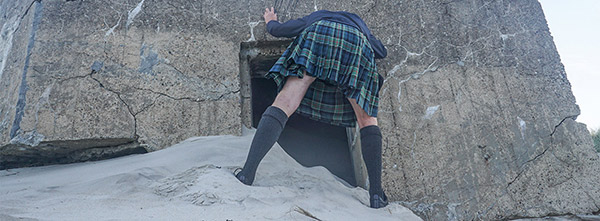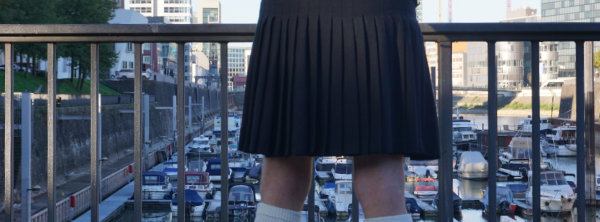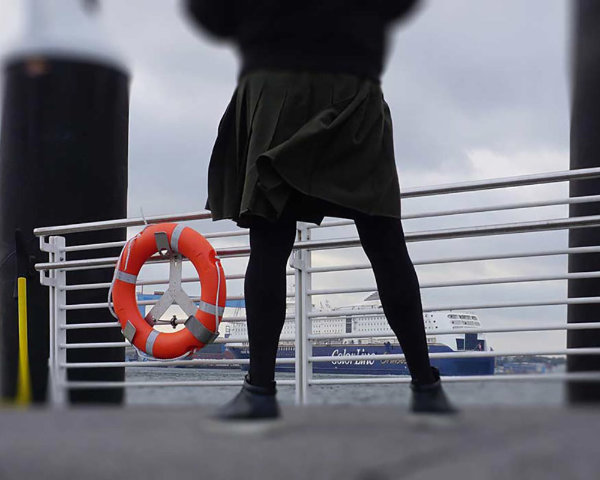Are 8 yards of fabric a must? Or will less do? How is a kilt constructed? Learn about straps and buckles, fell, rise, pleats, length, drop, and tartans.
A lot of fabric
If you open the kilt and place it flat on the floor, your first impression might be what a lot of fabric you have.

A kilt
A kilt consists of three parts. To the left you have the outer or over 'apron', to the right the under or inner 'apron', the first one to fasten, and in the center the pleated section which is to be at your rear.
Each of the aprons is half your waist size. The rest, the pleated section, will vary with the yardage of your kilt.
You can have 4, 5, 6, 7, and 8-yard kilts. One vendor even has a 2-yard kilt to offer.
Eight yards used to be the norm. Very cheap imported off-the-peg PV-kilts, as well as most expensive wool kilts, are still eight yarders. But today most fine wool kilts might be 5-yard kilts, due to them providing a good compromise between cost, authenticity, and comfort.
The fabric is often referred to as
the tartan, meaning both cloth and pattern.
According to Oxford Living Dictionaries, a tartan is:
A woollen cloth woven in one of several patterns of coloured checks and intersecting lines, especially of a design associated with a particular Scottish clan.
Nowadays the tartan can also be PV/acrylic. Cheap kilts always are.
Tartan weight
The tartan is defined by its
weight in ounces (1 oz. = 28.35 g) for one yard of double width cloth (about 60 inch = 140 cm).
An 8-yard kilt can in most cases be made of 4 yards double width or 8 yards single width tartan (about 30 inch wide).
Heavy weight = 16 oz.+might not be the optimal choice on a hot summer day. To most purists 16 oz. (or more) is a must, however.
Medium weight = 13 oz.is probably the most universal and popular weight for kilts today.
Lightweight = 10-11 oz.is primarily for kilts to be used in a hot climate. Purists will say that a lightweight kilt does not have the right swing and that it needs a lot of ironing. It is not what I have experienced myself.
Ultra-lightweight = 8 oz.Should you want a kilt that lightweight, you might take a look at Californian based
Sport Kilt.
In general, a heavy weight tartan is more expensive than a lightweight one, but the price is also affected by the
mill that delivers the tartan.
Tartan mills
Reputable tartan mills are Lochcarron, House of Edgar, Strathmore, Marton Mills, D.C. Dalgliesh (Clan.com owned), and a few more.
Given an 8-yard kilt takes 4 yards double width cloth the weight should in 16 oz. be over 1.8 kg plus lining, straps and buckles.
Reducing it to 5 yard 13 oz. means going down to about half the weight. And a 4 yard 8 oz. Velcro closed Sport Kilt is about 500 grams only.
Most of my kilts are 13 oz. 5 yard wool kilts.
Tartans
First of all, tartans are synonymous with the traditional kilt and more than 4.000 tartans are registered. They are
Clan (family) tartans for members of Scottish clans,
District tartans for men with an affinition to a certain geographical area.
Commemorative tartans to celebrate/remember something.
Universal tartans (fashion tartans) for men without clan affiliation.
Corporate tartans, designed for and registered by some companies.
Every man is free to wear any universal, commemorative, or district tartan. And no law forbids you to wear a clan tartan. Provided you wear your kilt in a proper way hardly anyone should object, should you be seen wearing "his" tartan.
And even when, how could anyone prove that you had no “right” to wear it? He himself would probably be wearing trousers, and, by all means, where would his own proof be?
Some tartans are more expensive than others. In general popular and wide spread (clan and universal) tartans are cheaper than district tartans.
A few examples

Tartans you are absolutely free to use.

Clan tartans. If you like them, buy them, wear them, but show respect.
Straps and buckles
A kilt is being held together by a strap and a buckle above each of your hips. At your right hip you sometimes have an extra buckle and a strap. But three are not better than two and two not better than three.

The strap which fastens the under apron to the buckle on your left.
Rise
At the top of your kilt you have the
rise. On a kilt, meant for day wear, it is about one inch, equalizing the difference between an ordinary belt and the wider kilt belt and accordingly in practice meaning no rise.
On a kilt to be worn with a Prince Charlie jacket, some kilt makers will make the rise higher to be sure that the top of the kilt is covered by the short jacket.
On military style kilts it may be as much as three inches. When ordering be careful with the kiltmaker's instructions. If rise is not mentioned, you may neglect it.
For casual wear a kilt without such rise looks way better than one optically sitting under your armpits!
Drop and length
What you measure in order to get the correct length of your kilt is in fact the
drop. And the length of the kilt is drop plus rise. But most often vendors use the words drop and length interchangeably and unless the kilt has an added rise, drop and kilt length shall be the same. But carefully check the instructions given by the vendor or maker.
Fell
On a kilt the pleats don’t flare out from the waist but are sewn down and together till where you are at the broadest, usually at your hips. This part is called the
fell. A kilt without a fell is no kilt and should be avoided. Ideally you should be asked about length of fell when ordering a kilt. You seldom are. Because not only within photography you talk about
rules of thirds. They also exist with kilts. As a matter of fact, on most men the correct height of the fell is one third of the kilt length,
when fastened at natural waist and reaching to the knees. Accordingly, you should expect the fell on a 24" kilt to be 8", on a 21" kilt 7". But if you want your kilt to sit lower or be shorter or both the rule leads to wrong results.
Say you want a kilt worn at jeans waist, but still have it end at the top of your knees. Instead of ordering a 24" kilt (with an 8" fell) you order it 22". The fell should, in your case, have been reduced by two inches as well, but probably you get it 7", being approx. 1/3 of 22". The fell is one inch too long.
If you want your kilt to be above your knees and therefore order a 22" long kilt to sit at your natural waist, you can again expect the fell being 7", which is one inch too short.
If you want your kilt shorter and sit at your jeans waist and therefore order it 20", the fell should have been 6", but it shall probably be 7" or one inch too long.
How serious is this? If you ask a kiltmaker, who is going to take your measures and make you an exquisite kilt he shall say that it is extremely important to have the fell correct. If you ask a vendor, having the kilt made to your measures, he shall tell you, that it is without importance. If you ask me, I'll say that a difference of one inch plus or minus is absolutely to live with, in a world being in many other respects far from perfect.

Pleats must be sewn down like on the red kilt, and not start at the waist.
Pleating
Regarding the pleats, standard is
knife pleated to the sett, meaning all the pleats go in the same direction, and that they are arranged in a way that the tartan looks approximately the same whether you are looking at the kilt from behind or from the front.
The pleating is the difficult part of kiltmaking, and the more precisely the pleating, the better your kilt shall look – and the more expensive it shall be.
Instead of having your kilt pleated to the sett, you may have it
knife pleated to the stripe, also called
military pleating. When pleated to the stripe, each of the pleats is arranged according to a chosen colour, rather than to the entire sett. Therefore the kilt shall look quite different when looked at from behind and from the front. Hardly to order on the internet.
A third option is
box pleated, meaning that the kilt shall have rather broad, flat panels on the back. Only by few kilt vendors you can order a box pleated kilt.
Apron Fringes
On a traditional kilt the outer apron will normally have fringes. Can be two or three, but also none may be a possibility. When you order a kilt on the internet it is rather unlikely that you shall be asked what you prefer.

Apron fringe.
Finishing
Your kilt can be hand stitched for utmost precision or it can be sewn on the machine. It can be made to your measures by a skilled kilt maker in Scotland or other parts of the UK, or in the US or Canada. Or it can be made in a factory in Pakistan or another low labour cost country – like practically all the clothes we otherwise buy, being they cheap or expensive brands.
What about prices?
I think above description gives you a picture of something costing a fortune and something perhaps pretty affordable. And you are right.
You can have a kilt setting you back £800 or £25. And everything in between.

Both are kilts.
The kilt to the left is £50, the one to the right five times as much. Both are kilts. Like cheap jeans and expensive jeans are jeans. Like cheap, as well as expensive cars, are cars.






































